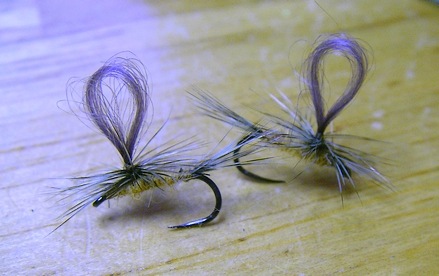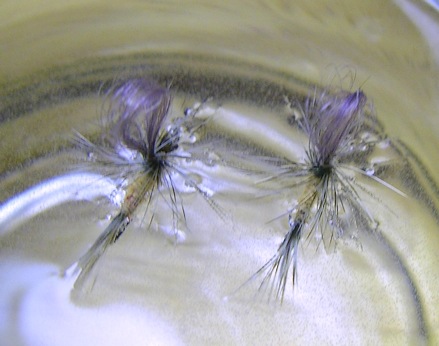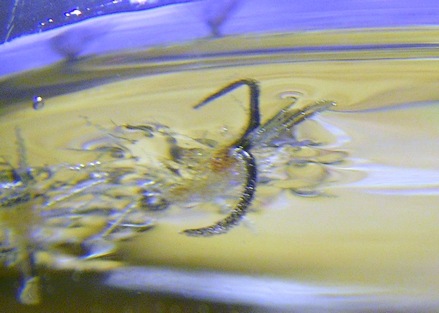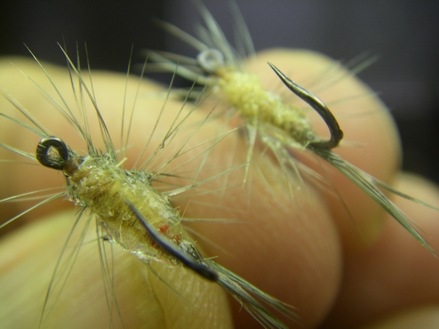With the casting club some four miles distant the round trip on a stingray was reserved for weekends. Weekdays it was the bathtub as trout stream surrogate.
A young lad learning to tie flies has to make due. Each time the UPS truck squealed to a stop out front it disgorged some new material from Dan Bailey’s or Kaufmann’s Streamborne, and I’d start the bathtub going to see why marabou was such a big deal, or determine whether a fly tied of polypropylene could survive the eddy between spigot and drain.
In those days everything was tied with Size A Black Nymo unless I was feeling gaudy and opted for white.
Six feet of monofilament tippet and a handful of experimentals tugged through the water using “hand-twist” retrieve. I learned which materials caused flies to ride sideways, upside down, and how stiff materials assisted by head cement spun the fly uncontrollably …
… but most importantly I learned what not to do, and how to make a shortcoming an asset.

… above are a couple Creamy-Orange Paraduns that I attribute to the Gary Warren – Chuck Stranahan – Hat Creek brain trust. Are the two shown the same?

The “Bath Tub” test shows the same two flies riding nicely. The left fly is starting to show it’s true colors …

The underwater view of the left fly shows a pronounced orange-red butt section by the tail. It’s revealed to be the Upper Sacramento variant of the Creamy-Orange with a butt of blood red thread underneath the dubbing.
Thread choice isn’t pronounced on the dry version of the fly, but all my “wet testing” of years ago confirmed that Black Nymo overwhelmed every color of dry fly dubbing tested.
Now I knew why Art Flick, Roy Steenrod, and Walt Dette, as well as every other past master of the dry fly used neutral gray thread.
The ensuing month saw me delivering papers frantically, husbanding tips while looking predaciously at the UPS truck and the inevitable squeal that would announce a gleaming 12-pack of gray 3/0 Monocord.
Thread can be many things – a boon as well as a detractor. It acts as a hidden color layer influencing the body color of the fly. In this case, the Upper Sacramento is home to a dusky red-bodied mayfly whose abdomen fades into a creamy orange color up by the wing roots.
Wrapping red thread under a lightly dubbed body gives me precise control over how that color bleeds through the dubbing, and how much it influences the body color of the fly. A light dusting of dubbing will bleed red, a little more dubbing will bleed less (dusky red).

Here’s the same two flies removed from the glass; the left fly shows a pronounced red butt, and the fly on the right has none. Both flies were tied with a neutral tan thread so as not to influence the dubbing color on the remainder of the fly.
Fish never see a dry fly, they only see floating flies that are wet.
Water has a tendency to darken every color one or two shades, and rather than spend all your efforts matching the natural with dry dubbing – doesn’t it make more sense to test the colors wet?
It may well have been the only wisdom learned in the ensuing couple of decades, if you believe my parents …
Tags: dry fly, thread as color, dubbing techniques, upper Sacramento river, Monocord, Nymo thread, butt section, Chuck Stranahan, Gary Warren, Roy Steenrod, Art Flick, Walt Dette, Catskill dry fly, hand twist retrieve, Dan bailey’s, Kaufmann’s Streamborne fly shop

I never really use much black thread for dry flies, but I also rarely give much thought to the thread that is under dubbing… obviously a more substantial difference on the lighter colored flies.
What material did you make the loopwings with?
Ray – the loop wing material is Mohair. It’s a tough and long fibered material that is used in dubbing mostly.
It is from the skeins shown in this article – which had a really nice medium blue dun.
http://singlebarbed.com/2009/12/10/big-on-yarn-but-even-bigger-on-frugal/
I should have guessed. it looked a lot like a natural hair, and I really like the profile it makes as a wing. Nice.